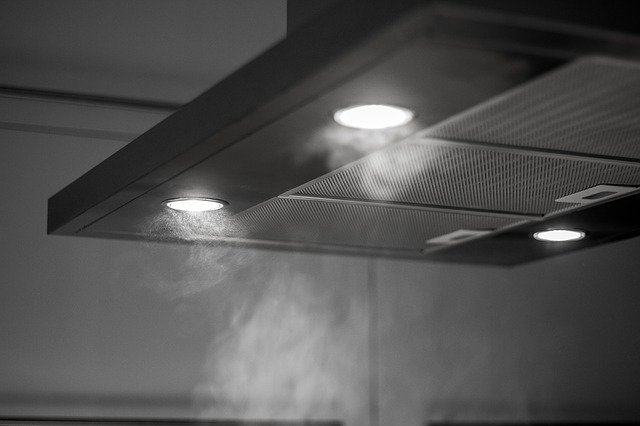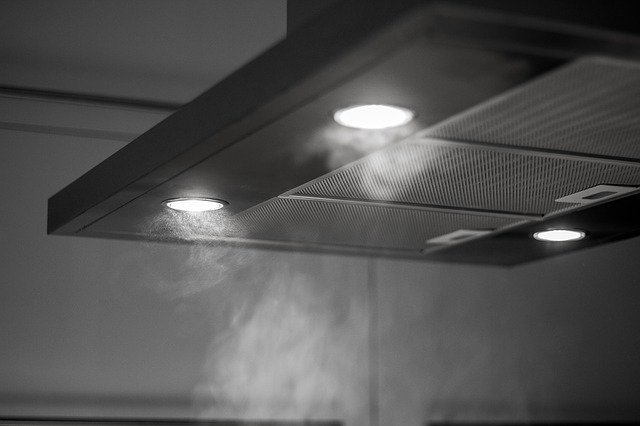
They might not be the first thing you think about when considering the threat/effects of poor air hygiene (and the subsequent impact on public health), however the sort of extractor fans typically found in kitchens shouldn't be overlooked. And not solely the preserve of larger scale industrial kitchen set-ups as favoured by a variety of businesses; but also instantly recognizable domestic kitchen settings.
But why is this so, you may ask yourself. Especially the 'threat to our health' bit.
Well, not to put too finer point on it (nor scaremonger too much), but a number of reasons quickly spring to mind which need addressing for the purposes of our continued health and general wellbeing. Both of which can be impacted by kitchen extraction systems which aren't doing their job properly. Or more importantly, safely for all concerned.
It's that old adage reappearing again, isn't it? What we can't see, can't harm us, right?
Sadly, yes. As grease, cooking oil and other deposits closely associated with the culinary world build up over a passage of time and often go unobserved. Yet can serve as a potential source of ignition within a kitchen space. Ignition as in spark. And for spark, read fire. Although an extreme risk, it's one we shouldn't discount because of that.
Normally we're talking about pretty noxious odours and broad hygiene risks which need flagging up; which also include vermin risk. The very type which a kitchen extraction system lends itself to, in terms of being the perfect magnet for grease, cooking oil and other ignition triggers discovered lurking.
Just How Important Is It To Maintain Kitchen Extraction Systems Cleanliness Then?
Very. So much so that in April 2006 it became an offence if systems failed to maintain an acceptable level of cleanliness and overall fit for purpose-ness. To the point that they were considered a genuine fire risk and rendered hugely important by the authoritative likes of the Health and Safety Executive (HSE) and the Association of British Insurers (ABI).
How Do I Know My Kitchen Extraction System Could Do With an MOT as Such?
It's not always going to be obvious, unfortunately, because in many scenarios the exterior of your kitchen extraction system may look clean. However it's what lies beneath which poses the problem(s). Unseen particles of which are probably the ideal kindling for a fire waiting to happen. And did you know that kitchen extraction systems are recognised as among the leading causes of fires? And therefore need to be cited near the top of your fire safety checklist.
The frequency of deep-cleaning protocols with regard to kitchen extraction systems largely depends on the size and purpose of your kitchen. TR19 regulations are the guidelines that govern good practice for the cleaning of ventilation ducts. As part of its governance the code of practice stipulates that as a minimum requirement systems should be cleaned annually, as a general rule of thumb. However that cycle is ramped up in the event that a kitchen is in use for over 16 hours per day, as higher traces of grease will obviously collect under these more commercial circumstances. With this in mind, legislative measures recommend that systems need to be cleaned every 2 months in these cases.
How Exactly Does Grease Wreak Such Havoc In a Kitchen?
Grease can create obstructions in the extractor system itself, and the engineered means by which we aim to keep our kitchens free of unwanted benefactors to poor air hygiene. This systematically disables the primary functionality of the assemblage, meaning heat, smoke and cooking odours aren't removed from the immediate atmosphere. And then there's the whole carbon monoxide question, which this leads us to.
Did You Just Say Carbon Monoxide?
We did. Because a fully-functioning, routinely maintained kitchen extraction system plays a vital role in the eliminating of potentially deadly fumes, including carbon monoxide. Which is very difficult to detect at the best of times as you're probably well versed in, on account of its odourless and colourless (non) appearance. Yet the undetected presence of which can and does result in severe poisoning and possibly death, if we're unknowingly exposed to high levels. Blocked kitchen extractors increase that risk.
Tell Me More About TR19....
First of all, let's quickly look at TR19 compliance and establish what it's about. Developed by the Building Engineering Services Association (BESA) almost 20 years ago, TR19 is the standard by which all commercial kitchens are run on; with a keen view to avoiding hazards. Amongst its guidelines, TR19 suggests maintenance of each section of the ventilation equipment. For example, the canopy, c pranopyenum, extractor fan and discharge duct. The premise being that no one area is left unturned (ducting-wise, specifically). And that throughout the system there is no grease that exceeds a thickness of 500um (.05 mm). Thus safeguarding against the risk of fire, due to heat, airflow and flammability of grease, per se.
TR19 is a document, first and foremost, not a qualification as such; a guide to good practice, essentially. To date here in the UK, individuals and companies carrying out kitchen extraction cleaning services haven't required a dedicated qualification. Those responsible simply needed to ensure that they complied with the good practices as outlined in TR19 literature; although 1-day training courses have been available.
Unsurprisingly some companies fell short on cleaning standards employed, as well as post-clean reporting and safe working practices noted by clients. Subsequently this led to many system cleaning being considered sub-standard, but going forward there are now acknowledged training courses cropping up which will raise standards related to professional kitchen extraction system cleaning, including the 3 day Grease Hygiene Operative Course (GHO) and the higher level Grease Hygiene Technician Course (GHT). Such industry-identifiable qualifications will ensure the standardisation of good working practices.
As of July 2019, another new specification was published regarding the Fire Risk Management of Grease Accumulation Within Kitchen Extract Systems. Known as TR/19 Grease, this revision to what went previously seeks to improve compliance standards with regards to kitchen extract fire safety cleaning. The update was believed necessary in light of some contractors failing to follow existing guidance properly, and in some cases, completely ignored it.
OK. So How Do I Adhere to TR19 Compliance. EG, What Must I Do to Determine Whether or Not My Kitchen Extraction System is Doing What it Should, When it Should?
When compiling the rebooted, farther-reaching version of TR19, the research gathered provided clear evidence as to why ventilation systems need to be fastidiously maintained, going as far as to reveal the link between residual or impacted dust and microbial activity that contaminates indoor air with harmful microorganisms.
In addition to this, the new TR19 documentation afforded commercial kitchen operators detailed guidance on how frequently they should have their grease extract systems cleaned. As a summarised glance at the key points highlighted within the current TR19 compliance, beneath we flag up the pivotal ones.
Ready Access to Mechanisms
• Ductwork systems should be free of any irregularities which attract grease/dust accumulation
• Extraction system must comprise sufficient quantity of separate panels for ease of access (re: routine inspection/cleaning). Said panels must be manufactured from same material as ductwork, and include insulation, seals to prevent leaks and quick release catches
Inspection of Mechanisms
• Inspection of ductwork needs to be performed at regular intervals to establish cleaning frequency (noting grease/dirt/dust accumulation)
• Specific tests such as Wet Film Thickness Test (WFTT) for grease (and other soft deposits) and Deposit Thickness Test (DTT) for harder, carbonised deposits, should be imposed
• Inspections must be undertaken at regular intervals not exceeding 12 months. More frequent inspections are required for precise measurement of the required cleaning interval. Specialists must carry out periodic inspections before and after cleaning the ductwork to assess whether the prescribed cleaning interval needs adjustments
Measurements of grease/dust deposits should be taken at following locations:
• Canopy/Extract plenum behind filters
• Duct 1 meter from canopy
• Duct 3 meters from canopy
• Duct midway between canopy and fan
• Duct upstream of fan
• Discharge duct downstream of fan
Cleaning Processes
• Hand Wipe - Wiping surface of ductwork system by hand
• Hand Scrape - Manually scraping heavy deposits off ductwork surfaces
• Chemicals - Utilising chemicals to soften (or dissolve) deposits, making it possible to scrape
• High Pressure Water Wash - Facilitating high pressure water (or vapour) lance to dislodge/dissolve deposits
• Blasting - Blasting contaminants off duct/component surfaces, to be vacuumed thereafter
Note: Water (or steam) washing techniques might not be appropriate/advised for ductwork systems situated above false ceilings or sensitive areas. In addition, after using chemicals or liquid cleaning methods, care must be taken so that the fluids and residues are cleared from the system.
TR19 recommended cleaning intervals are given below;
• Heavy use (12-16 hours a day) - Every 3 months
• Moderate use (6-12 hours a day) - Every 6 months
• Light use (2-6 hours a day) - Every 12 months
Post-Cleaning Verification Methods
Visually is the best method for ascertaining the cleanliness of the kitchen extraction system post-clean. Additional verification can be established courtesy of the abovementioned use of WFTT and DTT, and as according to the inspection methodology described above.
A Post-Cleaning Verification Report must state the following details, and can be presented in the future as a proof of cleanliness for environmental agencies and insurers;
• The system is cleaned
• Pre-clean measurements
• Post-clean measurements
• Photographic records
• Any additional works carried out
• COSHH data on any chemicals used
• Recommendations for future cleaning requirements
• Observations on the condition of the ductwork system
• Sketch (or schematic) of the system, indicating access panel, testing locations and highlighting any uncleaned areas with a written explanation as to why the area could not be accessed/cleaned
Footnote: Everyone has the right to healthy indoor air, which is why it's imperative that we all do everything in our power to ensure it remains of an optimum quality at all times. The proper maintenance of ductwork and ventilation systems is paramount and an integral part of this theory and practice.






